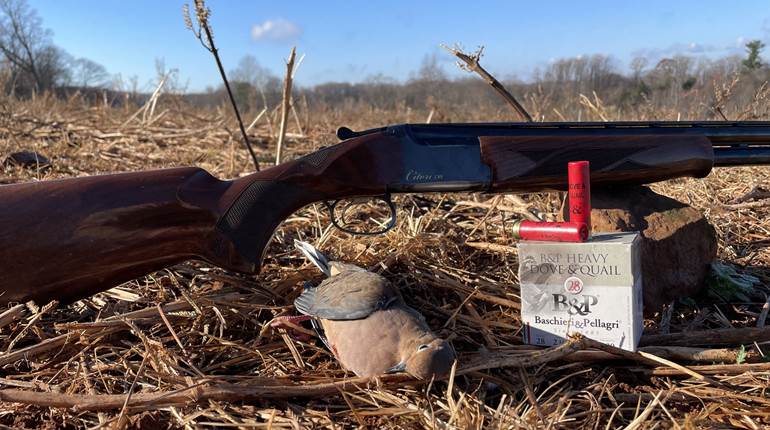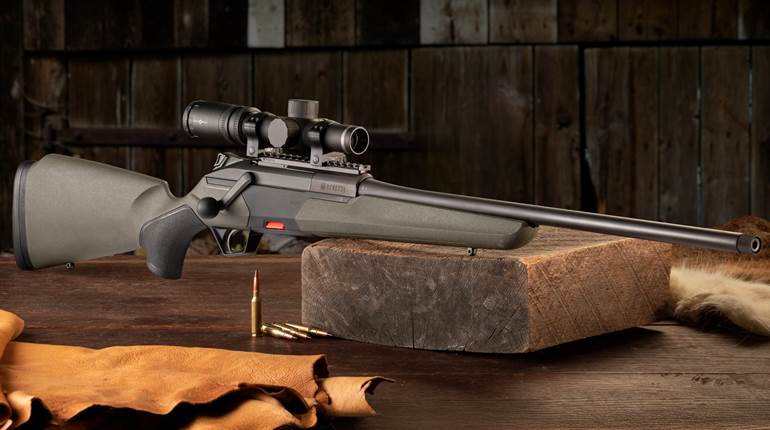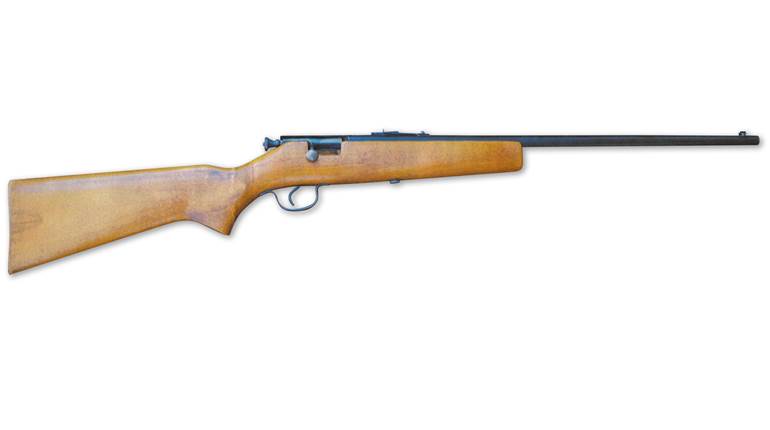
Although Savage Arms is best known for its value-priced, yet accurate and feature-filled Model 110-based hunting rifles, and more recently, its competition-ready Model 12 variants, since the early 1990s the company has offered tactical-oriented models in its law enforcement (LE) line. These rifles, however, are available for civilian sale. In 2009 the company unveiled its newest and most technologically advanced LE models to date: the 10 BAS-K and 10 BAT/S-K. The rifles represented not only Savage’s first venture into modular firearm construction, but also served as a means to a greater, more powerful, end.
“We needed to test the waters first before leaping,” said Marketing Manager Bill Dermody. “From the beginning we wanted to do a .338 Lapua Mag. But since we had never made a modular system before, we decided to do it in .308 Win. first. That was the right call, and we ended up with a better .338 Lapua Mag. because of it.”
In fact, so positive was feedback regarding the 10 BAS-K and 10 BAT/S-K rifles that, beginning in February/March 2009—shortly after the Model 10s were displayed at the SHOT Show—development of the .300 Win. Mag.- and .338 Lapua Mag.-chambered Model 110 BA got underway. Project Designer Steve Danneker was tasked with developing the rifle. He drew heavily from the smaller-caliber platform that had been developed by coworkers Jack Anderson and Dan Borecki, as well as feedback from Team Savage F-Class long-range shooters (Stan Pate, Darrell Buell, John Weil and Monte Milanuk) and shooter Pete Forras.
“General things about accuracy apply to a variety of products, and many of these were included in the initial design of this gun,” explained Dermody. “Then, when it came down to specifics, Team Savage members were our first test pilots. There were several iterations of prototypes and some pretty significant changes made based upon the feedback from these guys. Believe me; their fingerprints are all over that rifle.” Given the team’s success on the competitive scene—F-T/R—the world over, following its advice would prove a wise decision.
“As part of the Team USA F-T/R, itself part of the USA F-Class Team, Team Savage’s amazing abilities helped the American team win the world F-T/R championship this past summer, so when they gave me feedback, I listened,” added Danneker. “They gave me a laundry list of issues they found in shooting the rifles. Each issue was corrected based on the feedback.
“I first looked at the strengths of the Model 10 BAS-K and 10 BAT/S-K chassis system, and cranked them up a notch,” said Danneker. “Using the framework established with the short-action Model 10 variants, as well as what we learned from the Model 12 precision-target-series—Bench Rest and Palma—rifles, which I helped develop, laid the foundation for the Model 110 BA. But, even before the first rifle was built, everything was ‘grown’ from a SLA (Stereolithography Apparatus) before we ever cut a chip of material for this rifle. It gave me an actual rifle to have in my hand to feel what the real thing would be like before jumping into the cost of machining parts.”
The Model 110 BA’s modular stock design, with the buttstock, grip, bedding area and fore-end being separate pieces, certainly aided the change from short to long-action; however, completing the task was by no means easy. “It was a balancing act between the improved receiver lockup with the long, .338 Lapua Mag. magazine opening and the 110 receiver action screw location with the BA stock chassis system,” explained Danneker. “Essentially, I had to find the perfect balance between what the new chassis system could do with the 110 action for the .338 Lapua Mag.
“It looks like a long version of the Model 12 target action but has an extra-long opening— 3.90 inches —to accommodate the lengthy cartridge,” described Danneker. “Additionally, the lockup area is thicker, and the magazine well is made to fit the Accuracy International (AI) .338 Lapua Mag. detachable, single-stack magazine.” Why a single-stack magazine? “Double-stacks with these cartridges [.338 Lapua Mag. and similar] are a nightmare sometimes, and I wanted the most reliable component in this system,” he said.
“The black, five-round magazine is C.I.P. (Commission Internationale Permanente pour l’Epreuve des Armes à Feu Portatives) length, accepting up to a 3.760-inch overall length round, though most factory ammunition doesn’t exceed 3.600 inches,” reported Danneker. “It’s the longest that will fit into a Model 110 action and still feed, and it is based on AI’s C.I.P. magazine for its chassis system.” Except for modified feed lips and one additional round in capacity, the .300 Win. Mag. magazine mimics that of the .338 Lapua Mag. In addition to those from Accuracy International, Savage Arms will also source magazines from another supplier for the Model 110 BA.
Like the rifle’s Model 12 Palma and Bench Rest counterparts, but not the Model 10 BAS-K and BAT/S-K, the 110 BA received additional attention to detail to further enhance accuracy, though the Model 110 design is well-known for excellent accuracy anyway. According to Danneker, “I used very tight specifications we established for the receiver, barrel, bolt head and body, recoil lug and locknut. In testing the trued part versus the standard version on the Palma rifle project, we found the trued part usually resulted in groups half the size of those from non-trued components.” As such, the 110 BA received said treatment.
As for the Model 110 bolt, the floating bolt head, which has dual-opposing locking lugs and is widely acclaimed as an inherently accurate design, is a cross between the long heavy magnum and the shorter WSM. “It is the thickest and heaviest bolt head we make, assuring that we have the most robust and precise component in this rifle, explained Danneker. “Further, the bolt face and lock-up surfaces are trued to within 0.002 inches of the stem’s perpendicularity.” Instead of a standard rounded bolt knob, the 110 BA features a knurled, lengthened version that, according to Danneker, aids uplift and primary extraction. Extraction is via a sliding-plate extractor, located on the right lug, and ejection is by way of a spring-loaded ejector in the bolt face.
“Since the matte-black, 6061 T6 aluminum stock has the AccuStock built in, I made up a new recoil lug with the larger 1 1/8-inch shank,” said Danneker. “It is essentially a target recoil lug with the AccuStock profile ground flat to within 0.0005 inches, and the other side is parallel within 0.0005 inches.” The fore-end assembly was slightly modified from that of the Model 10 BAS-K and BAT/S-K; however, like the Model 10s the fore-end features three-swivel studs—one on each side and the third on the bottom, for attachment of a bipod. “I wanted to offer the shooter options if they want to attach a sling on either side,” explained Danneker. The 1 1/2-inch-loop sling attachment and quick-detach front sling mount on the Magpul buttstock can easily be moved to the other side, if preferred.
When designing the Model 110 BA’s barrel, performance and maneuverability were foremost considerations. To attain the “required” 3000-fps mark with a 250-grain projectile in the .338 Lapua Mag.-chambered variant, Danneker selected a 26-inch 4140 chrome-moly barrel. Including the muzzle brake, the free-floating barrel measures a lengthy, yet still manageable, 29.5 inches, giving the rifle an overall length of 50.5 inches. The .300 Win. Mag.-chambered 110 BA’s barrel mimics that of the .338 Lapua Mag. version. The rifle’s predecessors, the Model 10 BAS-K and BAT/S-K, had 24-inch barrels (not including the muzzle brake).
To reduce weight, as well as quicken cooling, the barrel has six, 15.5-inch-long flutes. At the receiver the barrel is 1.1250 inches in diameter, whereas at the junction with the muzzle brake it measures 0.900 inches. Depending on cartridge, the barrel is chambered with either C.I.P. (.338 Lapua Mag.) or Sporting Arms and Ammunition Manufacturers’ Institute (SAAMI) (.300 Win. Mag.) reamers from JGS Precision Tool of Coos Bay, Ore. Like the receiver and chassis, the barrel has a matte-black finish.
Although the rate of twist of the rifling in the .300 Win. Mag.-chambered 110 BA is the commonly encountered 1:10 inches, that for the .338 Lapua Mag. is anything but commonplace. Danneker selected 1:9-inch six-groove, right-hand-twist rifling. Why? “Considering the 0.338-inch options currently available, and knowing how bullets are evolving, such as all-copper and very-low-drag (VLD)-style projectiles, I opted for 1:90-inch twist, as it stabilizes the lengthiest of bullets at the cartridge’s maximum range,” reported Danneker. Most rifles chambered in .338 Lapua Mag. have a 1:10-inch or slower twist rate.
As the 110 BA is available in .338 Lapua Mag., the recoil of which is unpleasant for most shooters, muzzle brake design was critical. Danneker first tested an extra-large, modified version of the “fish gill” brake used on the .308 Win.-chambered Models 10 BAS-K and 10 BAT/S-K. In these rifles, recoil reduction was 20 percent; however, a greater percentage was desired for the 110 BA. Wisely, Danneker studied the marketplace, as well as his own gun cabinet, when contemplating a design. “I considered muzzle brakes currently in use, including that on my .50 BMG-chambered rifle, to see what made them work,” said Danneker. Although the research proved fruitful, so too did heeding the sage advice of Team Savage Capt. Stan Pate.
“Drawing from his extensive military and tactical shooting experience, Pate suggested filling the bottom of the muzzle brake’s ‘gills’ to channel gases up and out,” reported Danneker. “This would eliminate the dust cloud created when firing from the prone position, preventing ‘marking’ of the shooter’s position in a tactical situation.”
After making that change, Danneker employed high-speed video to observe the results. The findings were conclusive. “The muzzle brake channeled gases upward and backward, reducing muzzle flip, minimizing, if not eliminating, ‘marking’ and reduced recoil by upward of 35 percent,” he said. “Goal achieved!” So, what is the rifle’s recoil comparable to? According to Danneker, the .338 Lapua Mag.-chambered 110 BA produces recoil similar to that from a .308 Win.-chambered sporter-style rifle, and the .300 Win. Mag. is “very mild.”
One of the many salient selling points of the Model 10 BAS-K and 10 BAT/S-K rifles was their AR-15-style buttstocks, which allowed for interchangeability with any AR-15-compatiable replacement; however, the concept proved incompatible with the Model 110 BA. “I started with the Magpul PRS AR-15 version, but based upon feedback from Team Savage, it didn’t work for the length-of-pull and cheek adjustment we needed,” said Danneker. “I also wanted something in the 13.5- to 14 7/8-inch length-of-pull range and cheek adjustment suitable for shooters of all statures, as well as any optic/ring combination.”
Magpul’s PRS2 buttstock proved to be the “ideal” fit. The buttstock has a retracted length of 10.250 inches and extended length of 11 inches. Height adjustment is approximately 1 3/4 inches. Although Magpul makes polymer adapters for the PRS2 to fit G3 and FAL rifles, it didn’t work for Danneker on his concept rifle, so he developed one from aluminum that mates to the rear chassis using the hardware supplied with the stock. By opting for the PRS2 model, though, buttstock interchangeability is minimized. “Why someone would change it remains questionable, as you have a fantastic buttstock no sane person would want to replace,” said Dermody. I agree.
Also changed in the Model 110 BA from its Model 10 BAS-K and BAT/S-K cohorts is the pistol grip/trigger guard section. According to Danneker, this area was modified to give shooters better purchase to the DPMS AR-15-style grip. “This allowed the shooter’s fingers to rest where they should, on the middle of the first joint,” explained Danneker. “I made the stem thicker and wider for the heavier chamberings.”
Like the Model 10 variants, the Model 110 BA has a matte-black 6061 T6 aluminum M1913 Picatinny rail; however, to aid long-range shooting, the 18-inch rail has a 20-minute angle machined in, therefore requiring less adjustment in the optic. In addition to the top portion, which provides ample space for mounting an optic, as well as a forward section, the rail extends to each side, where 7-inch sections parallel the fore-end. Why? “We had a lot of feedback from the shooting and tactical suppliers requesting additional rails on the sides for accessories,” reported Danneker.
“I took the Model 10 version, lengthened it and added rails to the sides,” said Danneker. “This added some weight, but lightening cuts on the of the front portion help cut several ounces. I then dished the middle to accommodate large, 56-mm-objective riflescopes with low rings, which also helps keep shooters’ heads down and utilize the cheek adjustment range in the Magpul PRS2 buttstock. The rail is secured to the receiver by four No. 8-40 Farrell Industries screws, which was yet another suggestion from Team Savage. In comparison, the Model 10 BAS-K and BAT/S-K used four No. 6-48 screws. Although manufactured out-of-house, but still in the United States, the rail is machined to Savage’s specifications.
Like Savage’s other rifles, the Model 110 BA features the company’s user-adjustable AccuTrigger. In this case, it is the law enforcement version, offering a pull-weight range of 1.5. to 6 pounds. The test rifle’s trigger broke cleanly at 2 pounds, 4 ounces, and exhibited minimal overtravel.
As for controls, the 110 BA’s mimic those from previous Model 110-based rifles. The rifle features Savage’s standard three-position, tang-mounted safety, and the bolt release is positioned on the right, rear side of the receiver. Like the Model 10 BAS-K and BAT/S-K, the 110 BA’s magazine release is located on the front of the trigger guard, and pushing it forward releases the magazine.
Testing The Model 110 BA
As Team Savage played an integral part in the development of the 110 BA, and being world-class shooters, it only made sense that to realize the rifle’s full potential, accuracy testing needed to include them. So, in early October 2009 at the Douglas Ridge Rifle Club outside of Portland, Ore., we did just that. Having received two prototype rifles only days before my arrival, and working up some initial handloads, we evaluated their performance at 1,000 yards. Typical of Savage Arms’ products, accuracy was impressive—maintaining 1/2-m.o.a accuracy or less with the 250-grain loads with Team Savage members shooting. For me, the average increased, but remained less than one m.o.a.
Upon receiving the first production Model 110 BA for testing, I topped it with a Leupold Mark 4 8.5-25X 50 mm ER/T riflescope in Weaver rings, and headed to the 300-yard range with an assortment of ammunition. For stability, a Shooter’s Ridge bipod and a sandbag (for buttstock support) were used, and shots were taken from the prone position.
The best single five-shot group measured 1.29 inches (RUAG 250-grain Swiss P Target), and the best average for five consecutive, five-shot groups was 2.85 inches, and was produced by Cor-Bon’s 300-grain HPBT load. In most cases, three, if not four, shots impacted closely, but invariably, one, and at times, two, fliers enlarged the otherwise extremely tight group. Still, accuracy was commendable.
The muzzle brake, along with the 1 9/16-inch-thick semi-flexible recoil pad and rifle’s 15-pound, 12-ounce weight, made recoil quite tolerable. In fact, during the accuracy- and function-testing phase alone, I shot nearly 200 rounds in a single day and was no worse for wear. Hearing protection, and even doubling up, is highly recommended.
Although the Model 110 BA is found in the Savage Arms law enforcement lineup, and was designed with military requirements in mind, not to mention it has the ability to withstand operational use by military and law enforcement communities, long-range shooting enthusiasts will surely find this rifle appealing. What’s more, the 110 BA’s $2,267 price puts it within the reach of many shooters. All this, along with Savage’s renowned accuracy and commitment to quality, gives you a remarkable rifle at an equally impressive price.
Manufacturer: Savage Arms; (413) 642-4262; Savagearms.com
Caliber: .300 Win. Mag., 338 Lapua Mag. (tested)
Action Type: Bolt-action, repeating center-fire rifle
Receiver: 4140 chrome-moly steel
Barrel Length: 29½" with muzzle brake; 26" without
Rifling: 1:10" (.300 Win. Mag.), 1:9" (.338 Lapua Mag.), RH twist, six-groove, button-rifled
Magazine: Six-round (.300 Win. Mag.), five-round (.338 Lapua Mag.), detachable Accuracy International box
Sights: None; 18" 6061 T6 rail
Trigger Pull: Single-stage; 2 lbs., 4 ozs.
Stock: Magpul PRS2; fully adjustable for length of pull, drop at comb and drop at heel
Overall Length: 50.5"
Weight: 15 lbs., 12 ozs.
Accessories: Cable lock, manual
Suggested Retail Price: $2,267





































